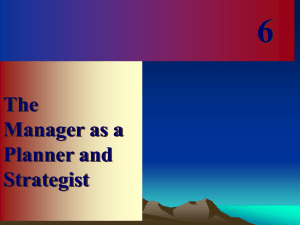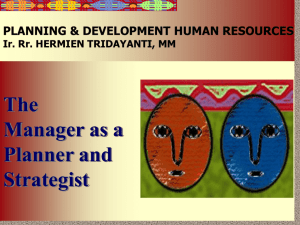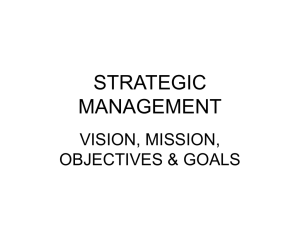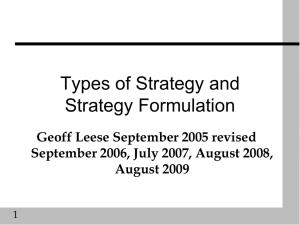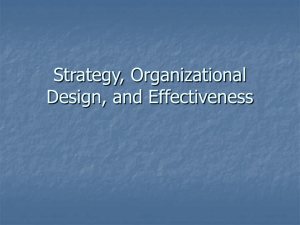Lecture 11
advertisement
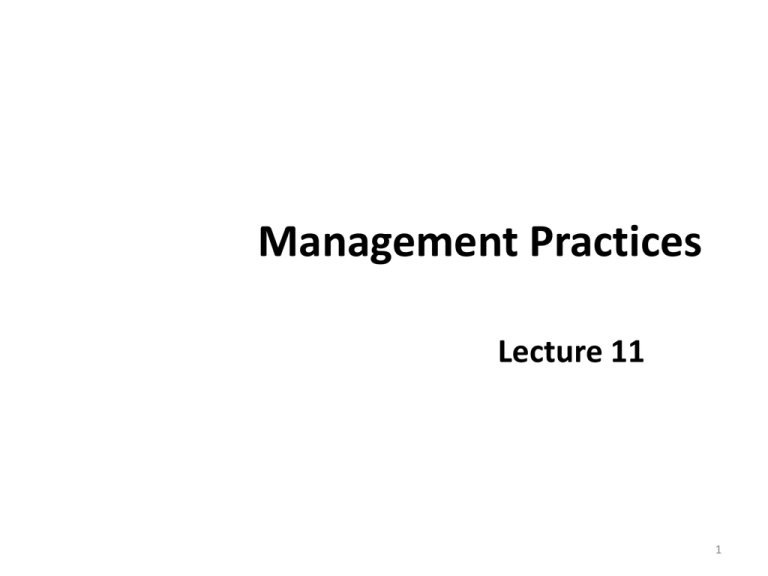
Management Practices Lecture 11 1 Recap • - Organizational Planning Importance of Planning Planning Process Level of Planning 2 Today’s Lecture • • • • Determining Mission and Goals Strategy Formulation Corporate-Level Strategies International Strategy 3 Determining Mission and Goals • This is the first step of the planning process and is accomplished by: A. Define the business: seeks to identify our customer and the needs we can and should satisfy. • This also pinpoints competitors. B. Establishing major goals: states who will compete in the business. • • Should stretch the organization to new heights. Goals must also be realistic and have a time period in which they are achieved. 4 Mission Statements Company Mission Statement While maintaining its leading position in Fauji Cement quality of cement maximize profitability through reduced cost of production and enhanced market share. AT&T We are dedicated to being the world’s best at bringing people together -- giving them easy access to each other and to the information and services they want and need -- anytime, anywhere. 5 Strategy Formulation • Managers analyze the current situation to develop strategies achieving the mission. • SWOT analysis: a planning to identify: – Organizational Strengths and Weaknesses. • • – Strengths: manufacturing ability, marketing skills. Weaknesses: high labor turnover, weak financials. Environmental Opportunities and Threats. • • Opportunities: new markets. Threats: economic recession, competitors 6 Planning & Strategy Formulation Corporate-level strategy develop a plan of action maximizing long-run value SWOT analysis identifies strengths & weaknesses inside the firm and opportunities & threats in the environment. Business-level strategy a plan of action to take advantage of opportunities and minimize threats Functional-level strategy a plan of action improving department’s ability to create value 7 Corporate-Level Strategies • Concentrate in single business: McDonalds focuses in the fast food business. – Can become very strong, but can be risky. • Diversification: Organization moves into new businesses and services. Related diversification: firm diversifies in similar areas to build upon existing divisions. Synergy: two divisions work together to obtain more than the sum of each separately. Unrelated diversification: buy business in new areas. • Build a portfolio of unrelated firms to reduce risk or trouble in one industry. Very hard to manage. 8 International Strategy • To what extent do we customize products and marketing for different national conditions? – Global strategy: a single, standard product and marketing approach is used in all countries. • • – Standardization provides for lower cost. Ignore national differences that others can address. Mulitdomestic strategy: products and marketing are customized for each country of operation. • • Customization provides for higher costs. Embraces national differences and depends on them for success. 9 Vertical Integration • When the firm is doing well, managers can add more value by producing its own inputs or distributing its products. – Backward vertical integration: the firm produces its own inputs. • • – McDonalds grows its own potatoes. Can lower the cost of supplies. Backward vertical integration: the firm distributes its outputs or products. • • McDonalds owns the final restaurant. Firm can lower costs and ensure final quality. 10 Vertical Value Chain Raw Materials Intermediate Manufacturing Assembly Distribution Backward Customer Forward 11 Number of market segments Business-level Strategies Many Low-Cost Differentiation Few Focused Low-Cost Focused Differentiated Low Cost Differentiation Strategy 12 Business Strategies – Low-cost: gain a competitive advantage by driving down organizational costs. • • – Differentiation: gain a competitive advantage by making your products different from competitors. • • – Managers manufacture at lower cost, reduce waste. Lower costs than competition mean lower prices. Differentiation must be valued by the customer. Successful differentiation allows you to charge more for a product. Stuck in the middle: It is difficult to simultaneously become differentiated and low cost. 13 Business Strategies • Firms also choose to serve the entire market or focus on a few segments. – Focused low-cost: try to serve one segment of the market but be the lowest cost in that segment. • – Cott Company seeks to achieve this in large retail chains. Focused differentiated: Firm again seeks to focus on one market segment but is the most differentiated in that segment. • BMW provides a good example. 14 Functional-level Strategies • Seeks to have each department add value to a good or service. • Marketing, service, production all add value to a good or service. – Value is added in two ways: 1. lower the operational costs of providing the value in products. 2. add new value to the product by differentiating. – Functional strategies must fit with business level strategies. 15 Goals for successful functional strategies 1. Attain superior efficiency: the measure of outputs for a given unit of input. 2. Attain superior quality: products that reliably do the job they were designed for. 3. Attain superior innovation: new, novel features about the product or process. 4. Attain superior responsiveness to customers: Know the customer needs and fill them. 16 Summary • • • • Determining Mission and Goals Strategy Formulation Corporate-Level Strategies International Strategy 17 Next Lecture Potential for Entry Power of Buyer Rivalry Among Organizations Substitute Products The Five Forces Model Power of Supplier
